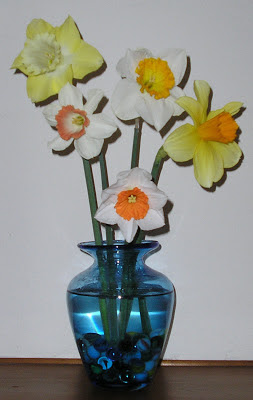 First, you cry.
First, you cry.You've waited through months of cold and rain with one thought in your mind: there will be daffodils. Eventually. There will be daffodils. And then, finally, there are daffodils. A few. But what there are a whole lot of are leaves and stems topped by brown, papery, dead-looking buds that never open.
You've just been bud-blasted.
It happened to me this year. And I was so ashamed! I thought I must have done something wrong. Most of my daffs have been in the ground for several years and aside from dutifully letting the leaves die down after blooming before I clear them away, I haven't done anything with them. I've added some compost now and then, but no special soil amendments. So I figured my neglect was probably the cause of these dead-on-arrival buds.
But after a bit of research, I've found that there could be some other reasons why my daffs suffered this fate. According to the American Daffodil Society, while lack of feeding may be to blame, other possibilities are not enough sun (they need at least a half-day of sun to set a bloom), unusual weather (heat waves or excessive rain) the previous spring when the bulb would have been forming the next flower, or a need to divide the bulbs if they've been in the same place for more than a few years. There are other possible causes having to do with planting or even viruses, but they don't seem to apply to my particular bulb problem.
So here's my plan for beating bulb blast next year:
- I'm applying a low-nitrogen, high-phosphorus and potassium fertilizer now, while the bulb is getting ready to produce the bloom for next year. (The ADS recommends a 5-10-10 fertilizer.)
- I'm leaving the leaves and stems in place until they die back naturally. I usually tie them into bundles with string or rafia to keep them tidier and to keep me from yanking them out when I'm weeding.
- After the greens have died back completely I'm going to dig up ALL the bulbs and check them for signs of disease or decomp. Any mushy bulbs will get tossed. I'll divide the bulbs as needed and store them until the fall somewhere cool and dry. (I keep those plastic mesh bags that onions and other vegetables are sometimes sold in in the stores for just this purpose. They keep the bulbs together but still allow air circulation around them.)
- In the fall, I'll replant the bulbs in a different part of my garden where they're going to get better sun exposure. The bed that I had them in is now more shaded by a growing tree than it used to be. I'll feed them again at the time of planting.



No comments:
Post a Comment
Note: Only a member of this blog may post a comment.